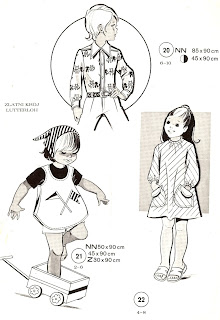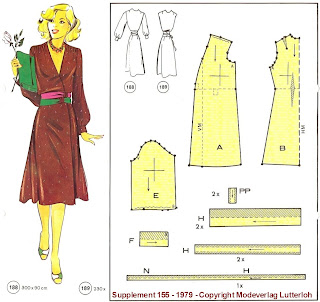This is the Blue group
and here is our first finished project!
Congratulations Joanne
What a great job figuring out a new way to do this pattern!

Making this jumper has been quite an enjoyable experience. It was somewhat like doing a puzzle...challenging to the mind, but I enjoy challenges. My main concern was my hip area. I wasn't so concerned how the top would turn out because my vest fit well without alterations, so I thought I could just make adjustments in the hips and thighs... well, it wasn't that easy!
My first challenges were in drawing out the pattern. The center front had so many dots and lines where it gathers that it was difficult to tell them apart. It also took me a while to figure out that the 5 dots going across the top of the center front were actually the neck line. It looked more like a shoulder seam to me, but after doing some basting and gathering the front, it was much easier to see. By the way, this gather line made the dress very difficult to paper fit...which lead to other difficulties later.
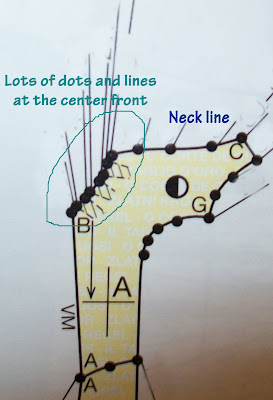
The other challenge I had with drawing the pattern was that my bust measurement made my waist dots come in what I thought was too far - so I ignored the waist dots and joined the ones above it to the dots below the waist. A mistake!
My next project was to figure the amount of fabric I would need. Thanks to the suggestions on a previous post on this blog, I laid out my pieces on the floor to measure. I bought exactly the right amount of fabric! Thanks for the post!
In sewing the jumper together I found that the waist was 7" too big and the bust 5" too big. I could take it in at the sides, side backs, and back - but not the side front because it would make the drop waist seam not match up.
The hips were just fine and the fitting was easy. I used 3/8" seams over the thigh and hip area. No problem there.
I didn't put a zipper in because the fabric is stretchy. It slips on nicely.
I think there are three reasons the top was too big.
1. I didn't do the waist dots right.
2. After looking at Ann's post - she doesn't add seam allowance for knits. This wasn't a knit, but it is stretchy. It probably has some spandex in it. I could have left out the seam allowances.
3. The last reason is that I now remember I used a smaller bust measurement to make the vest because I wanted it to fit when I drop some pounds. Perhaps if I had remembered and done that with this it would have not needed so much adjustment.
All in all, I am happy with the results. Thanks so much for letting me participate in this event and for all of the great information!
Joanne
***************************************************
Fonnell is working on this pattern
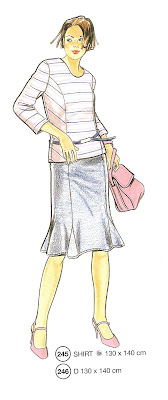

The first thing I consider in choosing a pattern is how it will look on me. Weight gain and weight loss can hit different area's of our body. A good look in a full length mirror will help you see your shape. Your shape will determine what looks good on it.
There are hints for every body shape for dressing. Now we have TV shows, book after book and even web sites devoted to finding your body shape and how to dress for it. I can make a couple of recommendations for books you might like. I use my local library a lot. But truly there is a lot of information on dressing for your shape.
I am 5 feet 5 inches tall and I am a balanced vertically. My waist is in the middle etc. I would work perfectly into the golden rule pattern for body shape in the vertical! It's the horizontal where I loose the battle. My rectangle shape has a bulge in it. My shoulders are slopping and this adds to the horizontal issues. I know I look better in skirts that slant as wide as my waist. I look better in princess line tops so that the eye will look down the line and go onto the skirt line and not focus on my heavier bust. So this is what took me to choose this pattern.
When I draw up my skirt pattern I will be very careful not to make it too tight. I want it to look balanced with my wider waist area. I love the godets because it will add some kick and width at the bottom so my legs don't look too small (yes they are smaller) If I make any one part of my body look smaller than the rest it will throw off the balance and that will make my large areas look larger and my smaller area's look much smaller. So reach for balance in your pattern choice.
My 2010 goal is to loose a lot of weight so the seams in this outfit will allow taking in as I go. I will be looking for some ways to make that easier as I go, like the buttoned elastic.
The top is made in a knit but I don't have to make that knit tight, I want to make sure it hangs off my shoulders without grabbing my waist. First I must choose the knit fabric before I even begin to make my pattern for the knit top. I need to know how much stretch is in my knit fabric. If you don't know about all the many kinds of knits and how to use each I highly recommend this online class, it's wonderful!
http://sewing.patternreview.com/cgi-in/sewingclasses/index.pl#342
This should be a quick outfit to make. In looking at the pattern right away I see that I need to pull the waist of the skirt out straight and perhaps make the sides a little wider so the skirt is makes a wider line than my waist. Likewise the top has a pulled in waist and a dart. I think I will straighten out the side seams and use my dart and seams to get the fit I want. The red lines just my plan. Knowing that I do this in most all patterns. There will be more I'm sure.

 Did you know that a 3/4" sleeve will bring the eye down past the middle of your body and draw the eye away from a larger bust? Where a sleeve ends can make a big difference in the flow of the eye. Can you picture my pattern with long or short sleeve. It makes the outfit look different.
Did you know that a 3/4" sleeve will bring the eye down past the middle of your body and draw the eye away from a larger bust? Where a sleeve ends can make a big difference in the flow of the eye. Can you picture my pattern with long or short sleeve. It makes the outfit look different.
Summing is all up: Knowing something about your body shape will help you choose your pattern. Finding patterns with extra seams will give us places to subtract or add to depending on our need.
Reading you could do to determine shape:
Dress Your Best by Clinton Kelly & Stacy London-I like this book because they used real people and let you see the outfits they thought would improve the body shape. My body shape wasn't exactly in the book but I learned a lot. Great read.
Does this make me look fat? by Leah Feldon-some drawings ,no photo examples but great written ideas IF you can picture what she is describing. What would a few pictures have hurt! She covers everything even jewelry choices so it's worth a read if you have time.
Looking Good by Nancy Nix Rice (Palmer/Pletsch) Great drawings and a nice brake down of subjects. Body shape is nicely covered. I skip the color work and fashion style, you can not put me in a box, in a group. It just won't work. Some days I'm classic some days I'm a romantic some days something else. Making the wall drawing of your shape really tells you a lot. This book looks like it walked out of the 80's so don't be looking for style just information on shape.
Fit for real People (Palmer/Pletsch)- Great information start to finish. This is a sewing book for getting a pattern to fit you but the examples are great and the first couple of chapters have tons of great info.
Dressed to kill.....gently By Peggy Sagers- I liked the way she determined your shape with a few measurements, the drawings get you thinking, but you decide what is right for dressing for yourself. I feel that's true with all the books they each have their own strong ideas but you must decide this for your own life, location and personality.
Staging Your comeback A complete beauty revival for women over 45 by Christopher Hopkins, also does it with measurements also and a nice little test or two. Fun. I loved this book, so Hollywood!
There are more but really....Lets choose a pattern and work!
********************************************************
This chart is for my body shape and tells me what outside shape I can use to best use with my own shape. The chart for all body shapes can be found in "looking Good by Nancy Nix-Rice (a palmer/pletsch)

As you can see if I do a triangle shape over my rectangle shape I get the illusion of hip curves....Well not exactly what I want....But the inverted triangle shape looks interesting. Keep watching for more of my sewing for weight and weight loss.
******************************************************************
As the next phase in making my outfit for weight loss I gathered some supplies.
A calculator, pencil and paper, tape measure, Scotch removable tape, my pattern page and my pattern paper, my packet with my tack and Lutterloh ruler, etc.
I know many of you bought your lutterloh system because you were told it would fit with little or no adjustment. I however share no such belief. I know ALL patterns need adjustments for me. So because this is very true I have taught myself how to adjust patterns. It leaves me having no fear of any pattern. You will find a great freedom to love your lutterloh patterns if you add some fitting skills. It's your choice. Learn to fit or put that book of patterns in the closet so that 10 years from now the next willing seamstress will have a chance at it. Sorry to put it so bluntly but I feel this is so often the case.
Now let me help you do a bit of fitting.
Measure yourself in a few more places:
Bust
chest (above bust)
Waist & distance from from shoulder over bust and down to waist
hips & distance from waist to hips.
width of your shoulder (from where your neck starts to where the bend in your shoulder is if you raise your arm)
Mostly this is all I need but I do keep a front cardboard sloper that notes how low I am willing to go in my neckline. This way if I love an outfit but it's too low I can lay the pattern drawn on my paper over my sloper and see how low and correct it. It's an easy fix to raise things up to where I prefer.
Ready
1. using your known number on the lutterloh tape, draw out your pattern pieces using your bust (or chest combined) and your hip measurment. Do Not cut them out yet and leave plenty of space around the drawing for adjustment.
2. Starting with the bust, measure the front and back pattern around the bust line, hopefully you will find this easy to find. One the waist once you measure the pattern you must also measure from the shoulder over the bust to the waist to see if your bodice pattern will be long enough. Same with the hip. This is just a beginning as paper fitting will tell us a lot more!
3. Get a paper and draw three column's on it. In the first put your measurements for each area. In the 2nd column put the measurements we are taking from the pattern. In the 3rd we will figure out our ease and our needs, write in the difference between the numbers in column 1 and 2.
4. I know that my chest and shoulders are much smaller than my bust so I make my lutterloh pattern with my chest size mostly and do the larger bust adjustment. If you know that is your issue do that now. (how to do this to follow or look it up online)
5. Note the difference in your measurement from the pattern. Is it very much? if you choose a princess seam like mine I have 8 seams to spread the changes within. note the difference in column 3
6. Continue to measure the pattern at the waist, hip and check that your shoulder is long enough or short enough.
Get all of this ready, all three columns filled in and stand by for what I will be doing next

write the figures on the back of the pattern if you wish

My front sloper with neckline low noted with red arrow
************************
http://sewingnhumming.blogspot.com/2009/09/difference-between-ease-and-fullness.html
Today I'm going to ask you to please read the posting on ease, link above. Or re-read it. All of what we do next is about the different factors of ease.
Get to know what amount of ease you like. If you are making a top go to your closet and find the top you like most. The one that feels good on you. If you don't have anything that you love the fit of you will have to experiment as we make Lutterloh patterns.
Now pinch on one side all the ease. Pinch at your bust and note the amount. Pinch at your waist and note the amount. Pinch at your hips (coats and long tops) and note the amount. For skirts and dresses be sure and pinch the hips also and maybe even lower taking note of the distance from the waist you took that pinch at. (measure one side of the pinch and double it)
Armed with the following you will be ready to adjust your pattern
1. Your list of favorite ease amounts (pinch project!)
2. your measurements for bust, high bust (chest), shoulder, waist and hips
3. The pattern you are makings measurements for these areas
Tomorrow I will have photos of how to do a paper pattern fitting so you won't make mistakes in the fabric but only on the paper!
If your chest measurement and Bust measurement are at least 2 inches different please go to this web site and read up on the larger bust change you can make.
http://www.timmelfabrics.com/fullbustalteration.htm
This link is so clear cut any one can adjust for a larger bust and I know I do it all the time!
http://sewmamasew.com/blog2/?p=486
This link has a project done step by step
Go ahead and test this out. Draw your pattern using the chest measurement and then make this adjustment. Paper only. Do a paper fit and see how it goes for you.
********************************************************

I think today I'd like to cover paper fitting your pattern. Above is a coat pattern one of our readers is trying to make. I find most everything I need to correct is found in paper fitting. First make your vest and get it fitting just perfect. Note everything you must change. When you draw up your pattern, before we do anything, you can make those changes you made in the vest. I always have to bring the hips up and make my shoulders smaller. Every time I make a pattern.
If you took your measurements and put them in a column you can now measure the pattern. Are there big differences? If so wait until the next posting to continue. But if you are almost matching in most areas then you have the correct size on the lutterloh tape and we just need to do some paper fitting!
Now it's time to paper fit the pattern you just fixed with the vest changes. Because I am a round person I leave the sides uncut on the paper pattern, but I cut out all the rest of the pattern. The extra paper on the sides allows me to add in the areas that I need most.

I have a sloper I lay on my patterns to see where I would be within that pattern. Already I can see that the arm scye is going to be tight, I can tell that the coat is too long and there is no ease in the pattern, which I know a coat needs. See what it looks like when I draw a line around the cardboard sloper onto the pattern.

It is hard to see white paper on a white table but click and it will enlarge.
see how my sloper lines are right against the pattern lines? That leaves me no ease at all.

This is a coat pattern and it has many pieces. You draw the multi-pieces as one and then cut them apart into two or three. Do draw some lines across the two pieces before cutting them apart. That way you can match them easily. In this pattern the back is in three pieces, the sleeve is in two.
This sews up like a jeans jacket. I think I'll make some in some fun tapestry fabric. It's heavy and can be worn unlined.

In pinning the pattern on the back half I carefully make sure the center of the pattern goes down the dress forms center. Or if trying on yourself make sure you pin the center to your center. (use what you are wearing to pin to) By keeping the pattern level and going down the center back I can see what needs to be adjusted.
I try to always adjust on the sides not the middles.
This pattern is too wide across the shoulders and not wide enough in the hips. I untape the sides to let the pattern open to what I need. later I will tape some paper in the space and divide it in the center. I use re-useable scotch tape so I can remove it for using the pattern for the fabric. You can't leave it on for a week or so it will just come undone!
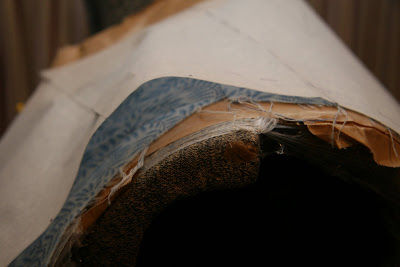
There are bubbles of fabric in the front and back shoulder. This means one of the pattern pieces is too long. Because this pattern has the back drop into the front it takes a little careful consideration to choose where to fit. Remember NEVER over fit. A coat needs more ease anyway. The sleeves will pull some of this bubbling down but I do want to shorten some of it.
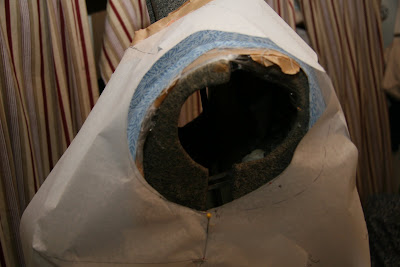

All fixed now. In the end I will change the shape of both pieces so that the impact of change is slight on the back piece and the front and so that the yoke line will be nice.
I like how it's fitting now.
Can you see how the back yoke is also the front yoke?
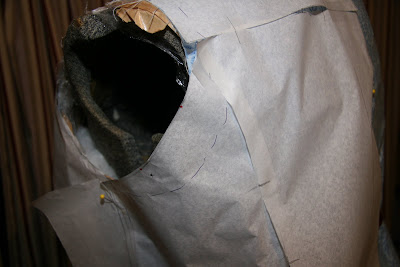
Here is the arm scye with both the front and the back put together. For sure I'll need to lower this some and then walk the sleeve into the pattern to see if I must add some on the sides of the sleeve. The sleeve is in two pieces but I would only add some to both edges.
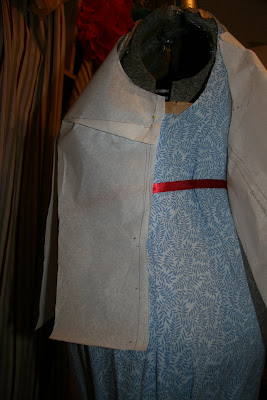
A better look at just the front piece. I added some on the side and then cut off the spare paper so I can fit the back to it. I DO NOT add my seam allowances or hems for paper fitting. Just butt your papers up to one another and put on a piece of tape.
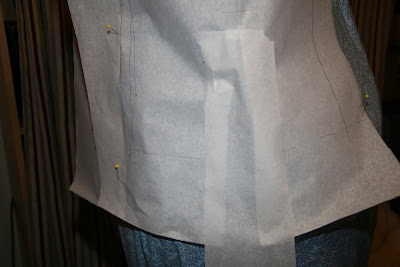
Here I have taped some paper in the opening in the back. Because this is where two pieces meet I will divide the paper down the center. Add horizonal lines for matching.
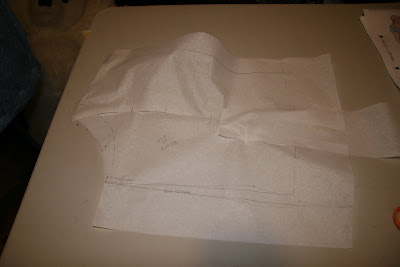
When I lay this bottom piece on the table it's clear it's not matched well. I leave the bottom taped so I don't loose how wide it needs to go and I re-tape the top until it's flat and then take a ruler and run it down the center. I cut it out and then just taped it back together. Now the jacket goes over my hips.
This outfit is too long for me. But I did all the changes first and then will shoten each piece at a place it won't change my work to fit the hips. You could shorten the coat first but if there are bust changes you might find you needed some of the length left in the pattern and you'd have to add it back...he he

Here is the whole pattern. The pattern was tight around the hips (or tummy!) so it didn't need the dart called for in the front. I however felt the style needs that dart and it makes a nice vertical line in my clothes to help me look slimmer. So I cut open the area where the dart would have gone and I will add paper there to make enough ease for a dart. It doesn't have to be a big dart just needs to give me that vertical line.
I'm still pretty sure I'll need to drop that arm scye some. This is a current fashion and it's not a factor of another time period. I find it odd the area is so tight. Someone else found it too loose. If you don't fold down the back so it bends into the front yoke you will have a much too large arm scye.
The neck is decorative and it may be too high on me so I'm going to put this paper pattern on myself and see. If so I'll bring it down some. I'll let you know how it fit me.
It's really nice if someone else will look at the paper pattern on you. Tell them to start at the top and look at one area at a time. If helps not possible strive for two mirrows so you can clearly see front and back. When doing this on yourself be patience and make tiny changes, re-try on and then make another change. It will help in avoiding mistakes.
I bought two mirrows at linens and things, the kind that hang over a door. I go up into the hall and am lucky to have two bedroom doors at the right angle for seeing the front and back.
Do you have any questions?
****************************************
Joanne is joining the BLUE Group:
"Hi Fonnell,
I think I would like to start off with your group. I have chosen this pattern and would like to make a jumper out of it. The jumper would be like 17 without the sleeves. My biggest challenge in fitting is the bottom half. I am definitely a pear! This pattern has a lot of seams in the lower half, so it might make fitting easier."

*********************************************
Cheryl is joining us. She has not had any luck in fitting other Lutterloh patterns and hopes to correct that this time around. Here is the pattern she is going to try. Very cute really.






